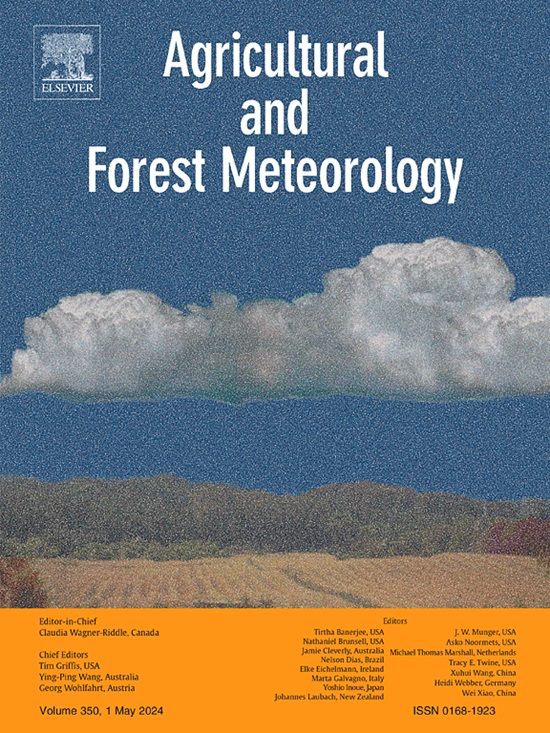The effects of atmospheric water demand, water availability, and exposure on the drought response of Swiss temperate forests
IF 5.7
1区 农林科学
Q1 AGRONOMY
引用次数: 0
Abstract
Projected increases in drought frequency and strength in Central Europe in the next two decades due to anthropogenic climate change pose challenges for European temperate forests. Understanding the correlation between drought stress, local conditions, and forest responses is crucial for effective forest management and climate mitigation measures. We examine how local water dynamics determine the response of Swiss forests during the European drought in 2018. We particularly investigate how increased atmospheric water demand, reduced soil water availability, and increased exposure of forests to potentially harsh abiotic conditions at the edge of the forest affect forest health.
We used Sentinel-2 data to calculate the normalized difference water index (NDWI) as proxy for forest health. Weather data, data from a process based hydrological model, a digital elevation model, and airborne LiDAR data were used to assess hydrological drivers. Our analysis revealed that forest exposure and water availability were more important than atmospheric water demand in explaining forest drought resistance. Regions with more limited water availability (47 % of Switzerland) had systematically higher proportions of forest areas that exhibited weak drought resistance (R² = 0.56 for moderate NDWI decrease and 0.55 for severe NDWI decrease). Forest exposure (i.e. the degree to which a forest patch stands out from the surroundings) could best explain weak drought resistance, with strong statistical relationships (R² = 0.69, R² = 0.50). Finally, atmospheric water demand had only a moderate effect on weak drought resistance (R² = 0.45 and 0.27). Our findings highlight the complex interplay of local water dynamics and forest responses to drought, while providing insights on how forest structure and exposure conditions at local scales affect responses and need to be considered when examining forest health under changing climatic conditions.
大气需水量、水分有效性和暴露对瑞士温带森林干旱响应的影响
由于人为气候变化,预计未来20年中欧干旱频率和强度将增加,这对欧洲温带森林构成挑战。了解干旱压力、当地条件和森林反应之间的相关性对于有效的森林管理和气候缓解措施至关重要。我们研究了当地的水动力学如何决定瑞士森林在2018年欧洲干旱期间的反应。我们特别研究了大气水需求的增加、土壤水可用性的减少以及森林边缘潜在的恶劣非生物条件的增加对森林健康的影响。利用Sentinel-2数据计算归一化差水指数(NDWI)作为森林健康的代表。天气数据、基于过程的水文模型数据、数字高程模型和机载激光雷达数据被用于评估水文驱动因素。分析表明,森林暴露和水分有效性比大气需水量更能解释森林抗旱性。水资源利用更有限的地区(瑞士的47%)表现出弱抗旱性的森林面积比例更高(中度NDWI下降R²= 0.56,重度NDWI下降R²= 0.55)。森林暴露(即森林斑块从周围环境中脱颖而出的程度)可以最好地解释弱抗旱性,具有很强的统计关系(R²= 0.69,R²= 0.50)。大气需水量仅对弱抗旱性有中等影响(R²= 0.45和0.27)。我们的研究结果强调了当地水动力学和森林对干旱的反应之间复杂的相互作用,同时提供了关于森林结构和暴露条件在当地尺度上如何影响反应的见解,以及在变化的气候条件下检查森林健康时需要考虑的问题。
本文章由计算机程序翻译,如有差异,请以英文原文为准。
求助全文
约1分钟内获得全文
求助全文
来源期刊
CiteScore
10.30
自引率
9.70%
发文量
415
审稿时长
69 days
期刊介绍:
Agricultural and Forest Meteorology is an international journal for the publication of original articles and reviews on the inter-relationship between meteorology, agriculture, forestry, and natural ecosystems. Emphasis is on basic and applied scientific research relevant to practical problems in the field of plant and soil sciences, ecology and biogeochemistry as affected by weather as well as climate variability and change. Theoretical models should be tested against experimental data. Articles must appeal to an international audience. Special issues devoted to single topics are also published.
Typical topics include canopy micrometeorology (e.g. canopy radiation transfer, turbulence near the ground, evapotranspiration, energy balance, fluxes of trace gases), micrometeorological instrumentation (e.g., sensors for trace gases, flux measurement instruments, radiation measurement techniques), aerobiology (e.g. the dispersion of pollen, spores, insects and pesticides), biometeorology (e.g. the effect of weather and climate on plant distribution, crop yield, water-use efficiency, and plant phenology), forest-fire/weather interactions, and feedbacks from vegetation to weather and the climate system.

 求助内容:
求助内容: 应助结果提醒方式:
应助结果提醒方式:


